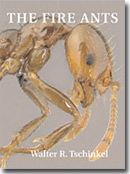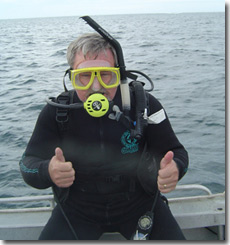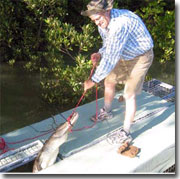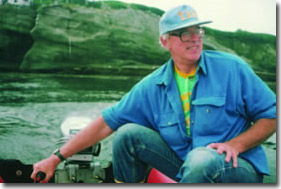Descriptions of Previous Lectures
Toby Daly-Engel
October 25, 2012 7 PM
Dr. Toby Daly-Engel, University of West Florida. The evolution of female promiscuity in aquatic predators.
Understanding reproductive strategies is necessary for effective management of top predators, whose life history often includes slow growth and few offspring. Traditionally, scientists have considered sexual promiscuity (mating with more than one partner in a breeding season) to be most advantageous to males, but research is showing this strategy to be increasingly common among females, especially in sharks. Hypotheses as to why this might be include skewed sex ratios during mating events, sexual conflict over evolutionary time, and genetic effects that benefit both females and their young.
Mark Hixon
September 20, 2012
Oregon State University. Alien Predator: Invasion of Atlantic coral reefs by Pacific Lionfish
Imagine the perfect alien invader -- a ferocious predator, beautiful and strange, covered in long poisonous spines -- but what if that alien invader were something released into our world by one of our neighbors? What if it began its life as a house pet? Marine biologist Mark Hixon shares his knowledge about Lionfish and their detrimental impact on coral reef habitats in the Atlantic, especially in the Bahamas where he has studied the reefs for more than two decades.
Mark Albis
July 12, 2012
Pacific red lionfish, introduced to Atlantic waters in the 1980s, have undergone a rapid range expansion and population explosion over the last decade. This invasive predator is now found across the Caribbean Sea, Gulf of Mexico, and southeastern coast of the United States.
Lionfish are voracious fast-growing predators of small fishes, represent a novel predator type in the invaded system, and are reaching larger maximum sizes and substantially higher densities than they do in their native Pacific. While there is much speculation about the negative effects of lionfish on native species, few experimental studies have actually examined them.
Dr. Albins changed all that by conducting controlled field experiments on coral-reefs in the Bahamas to examine the effects of lionfish on native fish communities. What he found was that lionfish caused substantial reductions in the abundance and species richness of small native fishes across ecologically important functional groups such as cleaners, predators, and herbivores. Lionfish also had stronger effects on native prey and grew more than six-times faster than a similarly sized native predator, the coney grouper. These results indicate that the lionfish invasion may have long-term, broad-scale impacts on the structure and function of invaded communities.
Harley Means
May 10, 2012
Apalachee Bay is underlain by a thick sequence of Tertiary marine carbonate rocks. As a result the geology of this region is dominated by karst. Numerous karst features occur along the Florida Big Bend coastline including sinkholes, caves and springs. This talk will focus on karst and how this process has shaped the landscape of Apalachee Bay. The local geology of this region will be tied to the broader geologic setting of Florida.
Dr. Paul R. Spitzer
April 12, 2012
While some have viewed loons as "primitive", in fact they are highly evolved and specialized as obligate water-dwelling birds. Their diving body is ballasted with solid bone and muscle. Heavy-bodied loons fly only with substantial, sustained effort. A lengthy stretch of water is necessary for takeoff and landing. But loons migrate from the North Country to the Gulf of Mexico and back every year. They are slow to mature, with a low reproductive rate, but remain a widespread and successful species. I argue that their longevity and complicated life-history require decisions, beyond hard-wired instinct. Scientific research seeks to understand the nature of this "loon intelligence", as seen in migratory strategies and flock-feeding. I term this "Celebratory Research", as we learn how these remarkable loons meet their migratory challenges, and use the habitats of the Gulf of Mexico.
Dr. Yannis Papstamatiou
March 8, 2012
Over the last 40 years, there has been a huge expansion in our knowledge and understanding of shark movements. For several species, we now understand where these animals move over short and long time periods. What is lagging, however, is an understanding of why these movements occur. Why do some sharks move into shallow water at night, or make seasonal migrations over 1000's of km? There are two approaches to answer these questions. 1) sophisticated statistical tools that extract as much information as possible from patterns of horizontal movements, 2) novel electronic tags that can directly measure behaviors and processes such as feeding, digestion, mating and energy expenditure. These tools have been used to study marine bird and mammal behavior for many years now, but only recently are we applying them to the study of sharks and other fishes. I will review some of these tools and techniques and give examples of how they can answer biological questions so that ultimately we will be able to describe where a shark is going, what it's doing, and why it's doing it.
Dr. Lon Wilkens
February 9, 2012
Animals with novel features are magnets for inquisitive biologists. Two unrelated animals, the Midwestern freshwater paddlefish and the local scallop, are quintessential examples whose functional morphology and natural history are distinctive. The paddlefish has a very long "nose", associated with neither its jaws nor sense of smell, and the scallop is one of only two bivalve mollusks (clams) that can swim. Both are better understood by examining the sensory biology and behavior of the animals. Indeed, the function of the paddlefish's paddle or rostrum was unknown until a few years ago when we discovered its role as an electrosensory antenna. Sporting an extensive array of ampullary electroreceptors similar to those better known in sharks and rays, this "antenna" is used to detect the weak electric fields of the planktonic water fleas that constitute its main diet. Feeding low on the food chain and growing disproportionately to large size, up to 70 kg., the filter-feeding paddlefish is the freshwater equivalent of baleen whales, the whale shark and manta ray. The fact that scallops swim, as a means of escaping predators and for migration, is more familiar. How they do it and the modifications in behavior and associated features of the bivalve shell, muscles, and nervous system are unique among clams. For example, whereas almost all clams are known for being difficult to open and "clam up" when disturbed, the scallop reverses this behavior opening wide upon contact with a predatory snail or starfish, offering tempting access to the soft tissues inside before jetting away. This talk will review the experiments that help us understand the natural history of these two animals and their unique behaviors.
Dr. David Noakes
January 19, 2012
The Oregon Hatchery Research Center was established to investigate mechanisms that produce differences between hatchery and wild fish, to provide educational and outreach opportunities to the public, and to help understand the conservation and management of native fishes in Oregon. In this presentation I will review some of our practical and theoretical approaches to accomplish this mission. Most of research is directed to Pacific salmon, and I will describe the interrelations among management, conservation and research on these species.
Brian Silliman
October 13, 2011
For over 60 year the paradigm of salt marsh ecosystems has been that physical factors, such as soil salinity and temperature, are the primary forces regulating marsh structure and function. My work over the past 10 years has overturned this theory and shown that consumers, such as blue crabs and fungal-farming snails, play an equally important role in organizing these intertidal grasslands. Without blue crabs, plant-grazing snails increase in numbers and mow down salt marsh grasses. We have also recently discovered that alligators, long thought to be freshwater inhabitants, are actually cryptic predators in marine waters and play a key, indirect role in marsh grass systems by affecting distribution and abundance of blue crabs. In this talk, I will present experimental results that support these conclusions, talk about implications for marsh conservation, and discuss how climate change will impact the strength of these interactions.
Markus Huettel
September 8, 2011
Crude oil from the Deepwater Horizon spill was washed onto sandy shores of the Northern Gulf of Mexico, and this presentation addresses the fate of this oil and its impact on microbial communities in oiled beach sands. After the accident, tar balls and pancake oil were deposited on the beach surface, and due to the subsequent deposition of sand layers, congealed oil and tar were embedded as deep as 75 cm in Florida beach sands. Oiled sand layers had elevated rates of oxygen consumption revealing enhanced degradation processes. Oil-degrading microorganisms grew in the beach sands and the community composition of the bacteria in Gulf beach sands changed.
Fran James
August 11, 2011
FSU Biological Science Faculty Member Emeritus, "The History and Natural History of Dog Island". The history and natural history of Dog Island. Dog Island is the easternmost barrier island off the panhandle of Florida. A review of its history and natural history can tell us how human and natural forces have shaped its present condition and what it may be like in the future. Today it is an ecological treasure.
Adam Warwick
July 14, 2011
The Florida Fish and Wildlife Conservation Commission (FWC) prohibited hunting of the Florida Black Bear (Ursus americanus floridanus) in 1994. Since that time, bears have rebounded to over 3,000 bears statewide and probably over 1,000 in the Apalachicola population. Florida's human population has concurrently grown from 5 million residents in 1960 to close to 18 million today and is projected to reach almost 36 million by 2060. Urban sprawl is encroaching on traditionally remote areas, bringing people into prime bear habitat. As a result, bears and people are encountering each other more than ever. Over 1 million acres of public land on the Forgotten Coast together has allowed bears ample room to thrive, but the potential for unregulated urban development exists. Florida's bear population deserves our best efforts in conserving and managing our wild lands. The many interesting characteristics of bears including their intellect have presented me with some unique interactions, and I will share some of these. I will discuss some characteristics and behaviors of the Forgotten Coast bears, where the most bears currently exist in this area, and the conservation challenges we will face in the future. These are just a couple of the topics I will cover during my talk, and will entertain as many questions as folks have.
John Carlson
June 9, 2011
The smalltooth sawfish, Pristis pectinata, occurs in shallow water near inshore bars, mangroves, and seagrass beds, and is occasionally found in deeper coastal waters. Populations once occurred from Texas to New York, but have declined by nearly 95% over the last 100 years due to intensive fishing pressure and habitat degradation. They are currently listed as endangered. Because there are such poor records of sawfish abundance and distribution records, the NOAA Fisheries established a National Sawfish Encounter Database to allow the general public to provide reports of sightings. In the absence of scientific surveys, scientists have used dockside interviews of recreational fishers to develop a time series of relative abundance of the core population. Using telemetry data, they have also been able to gain greater understanding of how freshwater flow affects sawfish movement patterns. Non-lethal ageing techniques and models of habitat fragmentation, despite some limitations, allow scientists to explore the impact of habitat loss on population recovery.
Jim Gelsleichter
May 12, 2011
As one of the largest oil spills in history in U.S.-controlled waters, the Deepwater Horizon Oil Spill has resulted in extensive contamination of Gulf of Mexico waters, posing both acute and chronic health risks to numerous marine wildlife populations. These threats extend from species residing in offshore waters within and/or adjacent to the primary contamination zone to the many ecologically, commercially, and recreationally important species that depend on nearshore and estuarine areas on Florida's Gulf coast as critical habitat. Given the population-level impacts that have occurred in some wildlife species as a result of chronic exposure to oil constituents from prior oil spills (for example, the Exxon Valdez oil spill), it is critical to monitor the health of Florida's fish populations to assess the full impacts of the Deepwater Horizon Oil Spill on an important component of the state's valuable natural resources. To address these concerns, Dr. Gelsleichter and researchers at numerous institutions including Florida State University's Coastal and Marine Laboratory (FSUCML) have recently initiated collaborative studies geared towards examining if coastal, pelagic, and deepwater fish residing on the eastern Gulf of Mexico have been exposed to and are experiencing effects of exposure to polycyclic aromatic hydrocarbons (PAHs), the most toxic constituents of oil. In this talk, Dr. Gelsleichter will provide an overview of these studies along with an overview of how researchers assess the impacts of environmental pollutants on fish populations.
Bill Pine
April 14, 2011
Gulf sturgeon are one of the most rare and interesting fish species in Florida owing to their large size, unique appearance, and their use of both riverine and coastal habitats. This presentation will cover the history of the Gulf sturgeon fishery in Florida and current population status and threats to this species including ongoing water allocation disputes within the Apalachicola-Chattahoochee-Flint River basin.
Craig Osenberg
March 10, 2011
In the past few years, many important ecological challenges have appeared on the front pages of our newspapers: e.g., climate change, oil spills, overfishing, and declines of coral reefs. Scientists engage in lively debate about the causes and consequences of these phenomenon, which often leaves the public confused about the "bottom lines". In this talk, I will draw from my work in marine systems to illustrate these debates and their importance. In particular, I will: 1) discuss the nature of experiments versus interventions and the scientific challenges they hold (e.g., drawing from the Deep Water Horizon spill); and 2) critique the effects of marine reserves, emphasizing the importance of scientific skepticism in illuminating new processes. Finally, I will discuss my basic research on vermetid gastropods - work that appears wholly inconsequential to society, but has revealed important processes that may be impinging on the continued health and resilience of coral reefs.
Peter Frederick
February 10, 2011
The Everglades is one of only a handful of wetlands worldwide that characteristically hosted huge breeding populations of herons, egrets, ibises, storks and spoonbills, sometimes numbering in the hundreds of thousands. More importantly, there exists over a century of historical nesting records that allow scientists a rare chance to understand ecological relationships of the birds in its unaltered state, and therefore, to understand how the natural functions of the ecosystem can be restored. The emerging picture suggests 1) drainage and impoundment of water have led to major declines in the ability of this nutrient-poor system to produce food for birds, 2) the birds have been most strongly affected by altered freshwater flows to the estuary, 3) disturbances like fires, droughts, floods and hurricanes are key to producing the immense pulses of food that large populations of birds depend on, and 4) sublethal contamination of birds by mercury can have strong effects on reproduction and mate choice. Many of these conclusions are also applicable to other wetlands and estuaries in the southeastern U.S. The scientific basis for restoring the ecological patterns that once supported large wading bird populations in the Everglades now seems quite strong, and the restoration process is now poised to move into a very active and crucial stage.
Jeff Chanton
January 13, 2011
Is Global Warming real? Could it have any effect on Florida? This presentation will inform you about the effects of climate change on the earth and how sea level may change. Two factors may cause sea level to rise, melting ice on land and warming seawater temperatures. Recent measurements indicate that the sea level rise rate has increased by as much as a factor of two. Factors influencing the earth's heat budget climate and the earth's response will be presented.
Dr. Donna Christie & Dr. Felicia Coleman
September 9, 2010
Now that Deepwater Horizon oil spill is capped, the media have turned to other news, and the tourists trickle back to Florida beaches, a question percolates to the surface for many of us, "What is the future of oil and gas development in the northeastern Gulf, and more specifically, for Florida?"
Dr. Donna Christie and Dr. Felicia Coleman join forces to address this question by reviewing the legal procedures that accompany oil and gas development, and the economic, legal, and ecological liabilities that lie therein. In the process, they review the Deepwater Horizon oil spill trajectory and the impact it has had on the way we think about energy use in the United States.

Dr. Christie is a leading authority on legal issues surrounding ocean and coastal management law, including ocean policy and fisheries management. She has been involved in this arena at the state level for Florida as well as at the national level as an author of the Review of U.S. Ocean and Coastal Law (Appendix 6), prepared for the U.S. Commission on Ocean Policy.

Dr. Coleman, an authority on marine ecology and fisheries management, has served on a number of federal panels charged with protecting marine resources, including the Gulf of Mexico Fishery Management Council and several National Research Council panels. Most recently, she was appointed as a member of the Marine Protected Areas Federal Advisory Committee.
Guy Means, Florida Geological Survey
July 8, 2010
Florida has more than 750 known springs which is one of the largest concentrations in the world. These springs occur from the Panhandle to central Florida. North Florida has an abundance of springs. Over the past 20 years spring water quality and quantity have declined due to human activities. Spring water quality is a reflection of the quality of water in our aquifer systems, which is where most Floridians get their drinking water. This talk will focus on where the largest concentrations of springs are in North Florida, why they occur where they do and what the implications are of declining spring water quality and quantity.
Dr. Michael Wetz, Florida State University Dept. of Earth, Ocean and Atmospheric Sciences
June 10, 2010
Algae represent a promising technology that can be applied towards solving two key societal problems: 1) need for a clean, carbon neutral biomass feedstock for biofuel production, and 2) need for a relatively inexpensive nutrient remediation technology. Algae grow and produce biomass rapidly, displaying productivities that exceed the best cellulosic biofuel crops by an order of magnitude or more. Through their growth, algae remove and sequester nutrients in a solid, harvestable form. We are developing state-of-the-art algal cultivation facilities on main campus at FSU and at the City of Tallahassee's T.P. Smith Municipal Wastewater Reclamation plant. Goals of our research are to create a stable biomass source for biofuel production, and to explore the possibility of growing algae using nutrient-impaired waters (incl. municipal wastewater) for purposes of "cleaning up" those waters.
Dr. Randall Hughes, FSU Coastal & Marine Laboratory
May 13, 2010
Given documented losses in species numbers and abundance, understanding the ecological effects of biodiversity is critical for conservation and restoration. Although there are certainly exceptions, experimental increases in marine biodiversity tend to have an overall positive effect on key processes like productivity. Perhaps more importantly, biodiversity generally increases ecosystem stability by providing "insurance" against disturbance: diverse communities are more likely to contain a species or individual capable of surviving and recovering from a particular stress or disturbance. In northern Florida salt marshes, plant species diversity enhances plant biomass by alleviating impacts of a grazing snail, potentially preventing die-off in this habitat. Diversity is not limited to differences among species, however, and even the number of genetic individuals in an area can have strong effects on the ability of ecosystems to withstand disturbance. For example, seagrass genetic diversity enhances seagrass biomass and productivity following a range of disturbances from algal blooms to heat stress. These varied and common disturbances represent a major threat to seagrasses, which are currently declining throughout their range. Importantly, plant genetic diversity also increases the abundance of animal species that live in seagrass habitats, several of which are ecologically and economically important. The available evidence suggests that diversity loss (species or genetic) in coastal marine habitats will threaten the productivity and persistence of these systems, particularly in the face of stresses such as global climate change.
Dr. Loren McClenachan, Florida State University Department of Biological Sciences
April 22, 2010
Non-traditional historical data sources-including observations by fishermen, nautical charts, and historical photographs-contain information that can be used to describe changes in marine ecosystems over time. Likewise, the social history of coastal communities can help to interpret the environmental history of the region. Florida's coastal communities have a rich social and ecological history, and this talk will explore interactions between people and the sea over time, including the early sponge industry, recreational fisheries, and the history of the Caribbean monk seal in Florida.
Dr. Chris Koenig, Florida State University Department of Biological Sciences
March 18, 2010
Goliath grouper (Epinephelus itajara), a species indigenous to the southeastern U.S., the Caribbean, Brazil, and the west coast of Africa has been overfished to the extent that the IUCN (World Conservation Union) has classified it as _critically endangered_. The species was protected in the southeastern U.S. in 1990 through action by Gulf of Mexico Fishery Management Council and the South Atlantic Fishery Management Council, the National Marine Fisheries Service, and the Florida Fish and Wildlife Conservation Commission. Since that time there has been a steady recovery, especially in Florida. We found that high quality mangroves, such as those that exist in the Ten Thousand Islands (TTI), are critical to the first 6 years of their development. However, because of the degraded state of most S. Florida mangroves, population recovery appears to depend in large part on the TTI and adjacent areas. I will present the results of our studies on the patterns of recovery and the ecology of goliath grouper in Florida, including regional densities, habitat characteristics, movements, diet, and spawning biology. I will also contrast our data with the current opinions circulating in the fishing community about the effects of the increasing goliath grouper population on other native species.
Dr. J. Wilson White, University of California, Davis, Bodega Marine Laboratory
February 18, 2010
There is growing evidence from around the globe that both fished and unfished populations of many marine species are declining in abundance and resilience. The implementation of marine protected areas (MPAs) is an increasingly popular remedy for this decline, and there is some empirical evidence that MPAs are successful in this role. However, the effectiveness of an MPA depends on the size of the protected area relative to the spatial scale and pattern of fish movement (both the adult stage and planktonic larvae), and on the intensity of fishing outside the MPA boundaries. These factors are uncertain or even unknown for most species, making it difficult to design MPAs that will protect an entire marine community effectively. I will present the results of simple mathematical models of fish populations that reveal the tradeoffs inherent in MPA design and yield relatively simple guidelines for MPA design in low-information settings. When adequate data are available, such guidelines can be augmented with the use of more sophisticated, species-specific models that integrate information on fish movement, ocean circulation, and fishing fleet behavior to project the biological and economic consequences of MPA implementation. I will describe the use of both simple guidelines and complex bioeconomic models in California, where a statewide network of MPAs is currently being designed and implemented using these models as scientific guidance.
Dr. Marc Mangel Department of Applied Mathematics and Statistics University of California, Santa Cruz
January 28, 2010
Marc Mangel was educated at the University of Illinois (BS in Physics 1971 with High Honors, MS in Biophysics 1972), where he was an EJ James Scholar, NIH Trainee in biophysics and elected to Phi Kappa Phi and Phi Beta Kappa, and the University of British Columbia (PhD in Applied Mathematics and Statistics, with a focus on Mathematical Biology, 1978). Dr. Mangel's research focuses on ecology, evolution and behavior and the broad goal of combining first-rate basic science with important applied questions.
The southern ocean krill Euphausia superba is a central to the entire ecosystem: everything in the southern ocean either eats krill directly or something that eats krill. Krill are also remarkably successful with a circumpolar distribution and an enormous biomass. However, climate change in the form of increased UV exposure due to ozone depletion, increased water and air temperatures, and decreases in ice may have profound implications for krill life histories and krill predators. Dr. Mangel's presentation will show, among other ideas, how classical fishery models can be used in novel ways to explore the consequences of warming water and fluctuating sea ice on krill biomass and changing UV on krill survival.
Gary Knight, Director, Florida Natural Areas Inventory
October 8, 2009
Gary Knight is Director of the Florida Natural Areas Inventory, a state-based research program that collects, interprets, and disseminates ecological information critical to the conservation of Florida's biodiversity. He has a graduate degree in Botany from Florida State University. In his presentation, Gary will address some of the many rare and imperiled species of the Florida Panhandle (with a special emphasis on plants), their habitats, and the status of conservation efforts in the region. He will also consider the information necessary for effective conservation planning and action, and will offer those attending the talk information on some cool web tools and sources of information for conservation planning.
Jack Rudloe Gulf Specimen Marine Lab
September 10 2009

Mr. Rudloe is the founder of Gulf Specimen Marine Laboratory. He is the author of 7 well-known books on Florida natural history and marine life. He achieved the first live exhibit of the world's largest isopod, the deep-sea giant sea roach. He was instrumental in the New York Aquarium's exhibit of the giant Surinam toadfish, also a first. He traveled to Malaysia and The People's Republic of China as a representative of the U.S. International Trade Commission to develop fisheries cooperative agreements. Jack will read from his and wife Anne's upcoming book, "Shrimp, the Endless Quest for Pink Gold." Says Rudloe, "It's a story about shrimp, the shrimp fishermen who roam the seas dragging for them, the farmers who grow them in ponds and the people who love to eat them. Farmers have provided a stable world wide supply of pond grown shrimp, which has made shrimp more widely available than ever before. Shrimp fishermen complain that cheap farmed shrimp is putting them out of business. It's a conflict as old as humanity itself, that of hunter- gatherers versus agriculture, or in this case 'aquaculture.' To this cast of characters, add environmentalists saying 'A plague on both your houses!' to farmers and fishermen, since trawlers kill sea turtles and thousands of tons of fish each year as part of the discarded by-catch and farmers destroy coastal mangrove forests to build their ponds. Then add biologists, fishery managers, Coast Guardsmen, deckhands, boat captains and seafood processors. Behind them are the bankers and other money men who fuel the gold rush mentality."
In his foreword to the book, Winston Groom, author of Forrest Gump, writes, "Rich in stories of seamen and the sea, Shrimp tells a fascinating story not only of the little creature itself, but of all the trials and tribulations the intrepid shrimper goes through to harvest him up. As scientists and marine biologists, the Rudloes know whereof they speak, and as writers have the talent and grace not only to put it in understandable language, but to make it interesting as well. Shrimp is one of those rare books that will do honor to any bookshelf."
Helen Light U.S. Geological Survey, Retired
August 13 2009

Apalachicola River levels have been declining for more than 50 years, with consequences to forests and streams throughout its extensive floodplain. Over the last three decades, the composition of floodplain forests has shifted to a drier mix of species, and further changes toward drier species could continue for many more decades. Swamp species (water tupelo, Ogeechee tupelo, bald cypress, and Carolina ash) have declined in density, with approximately 3.3 million fewer swamp trees estimated in a 2004-06 study than were reported in studies from 1976 to 1979. Some low bottomland hardwoods such as overcup oak and green ash have also declined in numbers in bottomland hardwood forests, while drier species such as water oak and hackberry have become more numerous. Floodplain streams, sloughs, and lakes are disconnected from the main river channel more often and for longer durations than 50 years ago, substantially decreasing offstream habitat for fishes, mussels, and other aquatic animals. Decreased flows have caused increased salinity in over 95 miles of streams in the lower tidal reach (tributaries and distributaries in the floodplain and main river channel). Declines in river flows and levels have been greatest in spring and summer, which are the most important seasons for biological processes such as tree growth and fish spawning. Since 1975, there has been less flow in spring and summer as a result of water use, flow regulation, reservoir evaporation, and changes in rainfall patterns in the basin upstream. These declines in flow have exacerbated earlier water-level declines that were caused by channel erosion from engineering works begun in the 1950s (dam construction and navigation improvements such as river straightening, dredging, and wood-debris removal).
Dr. David Kimbro FSU Coastal & Marine Laboratory
7 July 2009

Oyster reefs benefit coastal systems because they filter estuarine waters and provide habitat for ecologically and economically important invertebrates as well as fishes. Eighty-five percent of the world's oyster reefs, however, have been lost due to overharvesting and anthropogenic modifications of estuaries. Strategies being promoted to cease and possibly reverse these losses include increasing public awareness, restricting harvests, and restoring remnant reefs. Despite a cessation of commercial harvesting for almost a century and a series of restoration efforts for the past decade, oyster reefs along the Pacific coast have failed to recover. We show that historic and contemporary biological invasions of invertebrate predators from the Atlantic coast may be thwarting the conservation and recovery of oyster reefs in a relatively pristine California estuary. The rate at which these non-native predators deplete remnant California oyster reefs is dictated by links between estuarine circulation, coastal upwelling, and climate that control (1) how quickly oysters grow to sizes that are less vulnerable to predators and (2) when new oysters are delivered to depleted populations. Thus, conserving and restoring our remaining oyster reefs will also require identifying and then managing regionally specific controls of oyster mortality, growth, and recruitment.
Dr. Walter Tschinkel FSU Department of Biological Science
11 June 2009

Walter Tschinkel's passion for fire ants has been stoked by over 30 years of exploring the rhythm and drama of their biology. Tschinkel describes how they found colonies, construct and defend their nests, forage and distribute food, struggle among themselves for primacy, and even relocate entire colonies. His book, The Fire Ants, published by Harvard University Press, received an Honorable Mention at the 2006 Professional/Scholarly Publishing Annual Award Competition in Biological Science.
Dr. Steve Geiger, Florida Fish and Wildlife Research Institute
14 May 2009
Status of Bay Scallops (Argopecten irradians) in Florida west coast waters.

Florida bay scallop monitoring, management and restoration have progressed from simple restoration projects in 1972 to the current comprehensive program.
The initial FWC bay scallop program conducted adult abundance surveys and measured seasonal recruitment in historically fished estuaries. Presently, annual surveys and year-round recruit monitoring have expanded into most gulf-coast estuaries. This 16-year study has revealed long-term shifts and dramatic variability in adult populations. Recruit monitoring has found that scallops recruit in both discrete peaks in fall and spring as well as in protracted periods of very low recruitment.
Initial efforts to restore bay scallops focused on simple broodstock transfers and switched to reliance on hatchery-reared broodstock enhancement. In 2003 the release of pediveliger larvae into field enclosures in Pine Island Sound resulted in dramatic recovery of this local population. A similarly coincident recovery followed larval release in Tampa Bay.
Today, the primary goal of scallop restoration in Florida involves multi-institutional cooperation with the goal of restoring critical links in the Gulf coast metapopulation. As a sign of resurgent population levels, wild spat collection has increased dramatically, both in duration and intensity, to the point where harvest of wild spat provides seed for expanded restoration efforts.
Dr. Ken Heck, Dauphin Island Sea Lab, Alabama
9 April 2009
Consumers Rule: The Primacy of Top-down Effects in Shallow Benthic Ecosystems

Individual scientists, scientific organizations, and government agencies have all concluded that nutrient enrichment is among the most detrimental of human activities that affect coastal ecosystems, and large sums have been expended to study the negative consequences of nutrient pollution. Most studies of nutrient enrichment, however, were conducted long after the number and diversity of larger marine consumers had been dramatically reduced by centuries of intense harvesting. It is now understood that these once abundant predators played pivotal roles in regulating ecosystem structure and function, and that overharvesting of large consumers can trigger indirect effects that alter species composition in ways similar to those thought to result from nutrient enrichment. I will review experimental assessments of the extent to which changes in either nutrient supply or consumer abundance alter algal biomass in seagrass meadows, coral reefs and rocky shores. This review will show that consumer effects are the primary drivers of coastal benthic ecosystem structure and function. One important implication is that reducing nutrient input to coastal waters is unlikely to reduce algal biomass (or increase seagrass meadows or coral reefs) if overharvesting of predators has greatly altered food webs
Dr. Anne Rudloe, Florida State University
12 March 2009
Sea Turtles - A Race for Survival

Turtles are everywhere, quietly bearing their shells through deserts, ponds and woods. Of some 250 species of turtles, few have attracted more interest than the flippered behemoths that swim the world's oceans. Greens, loggerheads, ridleys, hawksbills, leatherbacks -- all are big, weighing from 35-500 kg.
Between them, the 7 species of modern sea turtles have adapted to nearly every available marine environment, becoming a widespread and ecologically successful lineage. They are dominant predators and /or grazers in their respective habitats, be it deep sea, coral reef or sea grass bed. Most seem to share drifting high seas live style as babies, foraging for their first several years in food rich areas where currents come together and sargassum weed and other drifting material concentrates. When they outgrow that food supply, they move inshore to take up the specialized life style of their own species.fa
Elegant greens graze tropical undersea meadows of sea grass, 1500 pound leatherbacks dive thousands of feet into the black frigid depths to harvest jellyfish, routinely accessing a world that is almost beyond human reach. Kemp's ridleys hunt crabs in a foot of muddy water around coastal oyster bars. Heavy yellow loggerheads crush snails and horseshoe crabs along temperate continental shelves while olive ridleys ride the waves of the open ocean. Hawksbills patrol the sunlit tropical shallows around coral reefs, one of the few species to ever master the art of eating sponges.
Dr. Donald R. Strong University of California, Davis
12 February 2009
Ecological and Evolutionary Misadventures of Invasive Spartina.

Maritime Spartina species are powerful ecological engineers, defining shorelines of temperate coasts. They grow lower on the tidal plane than other vascular plants, and stiff stems precipitate sediments into which roots grow from below. The potential to terrestrialize shorelines was the rationale of many of the scores of Spartina introductions to Europe, China, and the Pacific. Failing in this purpose and competing vigorously with native species, Spartina introductions have largely turned out to be a bane to both the ecology and to human uses of salt marshes. Monocultures and rapid spread in areas without native Spartina species has been the norm, while a lesser number of introductions has led to highly invasive hybrids between native and introduced Spartinaspecies. Rapid evolution driven by selection of genotypes particularly adapted for invasive behavior is a fascinating aspect of some hybrid cordgrasses. The study of Spartina introductions is a rich mixture of social and basic sciences, combining human values, ecology, and evolution.
Dr. John Bruno, University of North Carolina, Chapel Hill
22 January 2009
Florida's coral reefs: threats, decline, management, and signs of hope

A variety of human activities have contributed to the recent global decline of reef-building corals. One strategy for mitigating these threats is through local fisheries regulations, such as the implementation of Marine Protected Area (MPAs), designed to increase "reef resilience." MPAs could in theory benefit corals by restoring coral reef food webs, by preventing destructive fishing practices and anchor damage, and, if they include a terrestrial component, by reducing run-off that leads to sedimentation and nutrient pollution. However, the results of a series of field experiments, longitudinal studies, and meta-analyses by Bruno and colleagues indicate that although MPAs can indeed reduce coral losses, they are not completely sufficient. The key drivers of coral mortality and loss are nearly all regional- to global-scale stressors directly or indirectly linked to climate change, including ocean warming and acidification and coral predator and disease outbreaks. Thus, restoring corals and their role as foundation species will require a range of management actions, specifically directed at each of the known causes of coral decline operating at multiple scales.
Dr. Robert Paine, University of Washington
9 January 2009
Food webs: from Baymouth Bar to keystone species, interaction strengths and beyond

Food webs for the last century have been viewed as a convenient way to portray networks of ecological interactions. My interests began in the late 1950s on Bay Mouth Bar. Early experiments on the Pacific coast developed the concepts of keystone species and trophic cascades. Field experiments eventually quantified when per capita interactions were strong or weak, and these in turn have identified the relationship between web structure and ecosystem function. I will make no apologies for an unabashedly top-down perspective in which process generates observable pattern.

